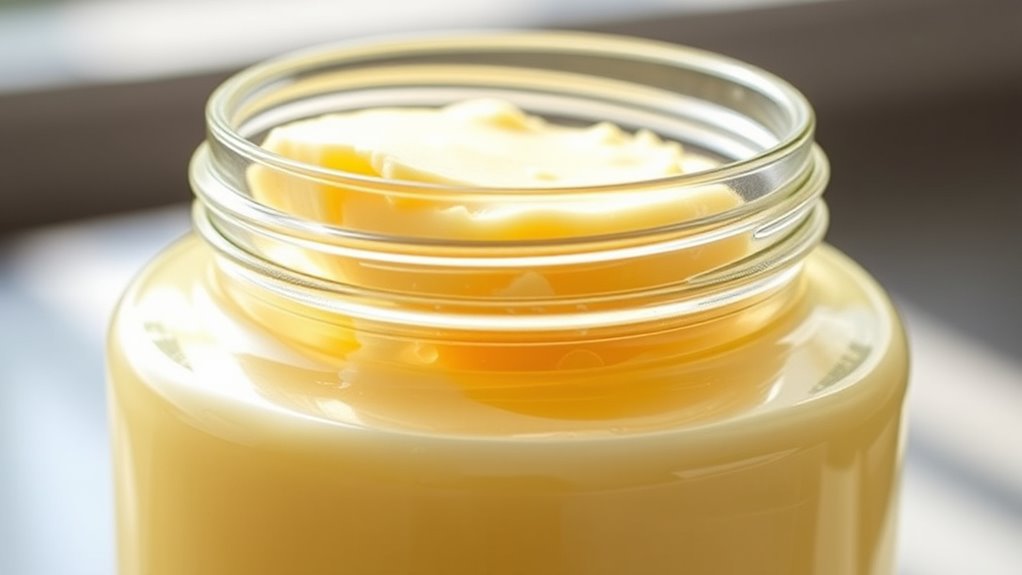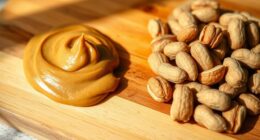Centrifuge‑clarified butter is crafted through high-speed spinning that removes impurities, resulting in ultra-clear, smoke‑free dairy products. This process efficiently separates fats, proteins, and unwanted solids, enhancing the butter’s purity and flavor. The benefits include a smooth texture, richer taste, and improved shelf life. If you want to understand how this innovative technique guarantees top-quality butter, exploring further will reveal the detailed steps and advantages behind this modern approach.
Key Takeaways
- Centrifuge clarification removes impurities, fats, and proteins to produce ultra-clear, smoke-free butter.
- High-speed centrifugation accelerates separation, ensuring a purer butter with minimal off-flavors.
- Proper processing and filtration prevent residue buildup, maintaining butter’s clarity and smoke-free quality.
- Regular equipment maintenance and quality control ensure consistent production of ultra-clear, high-quality butter.
- Sealed packaging and strict safety protocols preserve butter’s purity and prevent contaminants during storage and transport.
Understanding the Clarification Process in Dairy Production

Understanding the clarification process in dairy production begins with recognizing how raw milk is transformed into a refined product. It starts with dairy fermentation, where microbes break down milk components, developing flavors and the butter aroma you enjoy. During this stage, unwanted solids and impurities begin to separate naturally. Clarification then involves removing these impurities to improve purity and quality. Traditional methods rely on settling or filtration, but centrifugation accelerates this process, ensuring a clearer, more consistent product. This step is essential for achieving butter with minimal off-flavors and reduced impurities. Additionally, the choice of projector technology can influence how visual elements like packaging or instructional content are presented in dairy production environments. By understanding how fermentation influences flavor and how clarification refines the milk, you can better appreciate the meticulous process that leads to high-quality, pure butter.
The Role of Centrifugation in Enhancing Butter Purity

Centrifugation plays a crucial role in enhancing butter purity by rapidly separating impurities from the milk. This process removes fats, proteins, and other particles, resulting in ultra-clear, smoke-free butter. It also helps eliminate undesirable elements like algae residues from algae cultivation, ensuring a cleaner product. The high-speed spinning concentrates impurities, which can then be separated efficiently. Additionally, understanding the family background of key figures can provide deeper insight into their personal and professional lives.
Step-by-Step Manufacturing of Centrifuge‑Clarified Butter
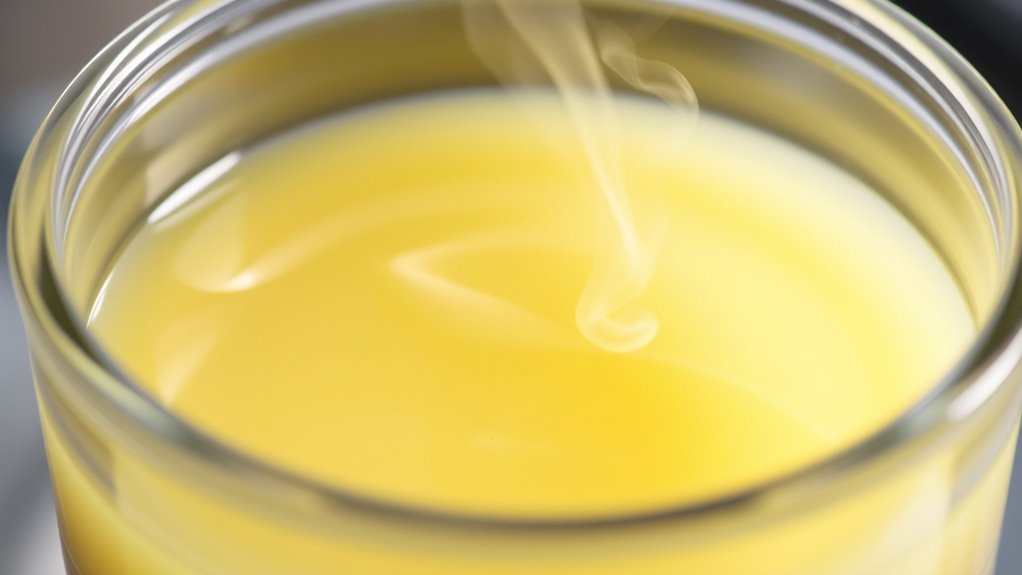
To produce centrifuge‑clarified butter, start by collecting fresh milk and ensuring it’s free from contaminants. Then, use a centrifuge to spin the milk, separating cream from skim milk efficiently. Next, extract the cream and gently heat it to melt the fat, then pass it through the centrifuge again to refine purity. Once you have ultra-clear butter, focus on packaging aesthetics to highlight its transparency and quality. Attractive, minimalist packaging can enhance its premium appeal, catching consumers’ attention easily. Incorporate clear marketing strategies emphasizing its smoke-free and ultra-clear qualities to differentiate your product in the market. Proper packaging and strategic branding will help you communicate the butter’s superior purity, making it more appealing to health-conscious buyers and establishing a strong market presence. Ensuring compatibility with headphones can improve the overall quality of audio in promotional videos, enhancing customer engagement.
Benefits of Ultra‑Clear Butter for Consumers and Producers
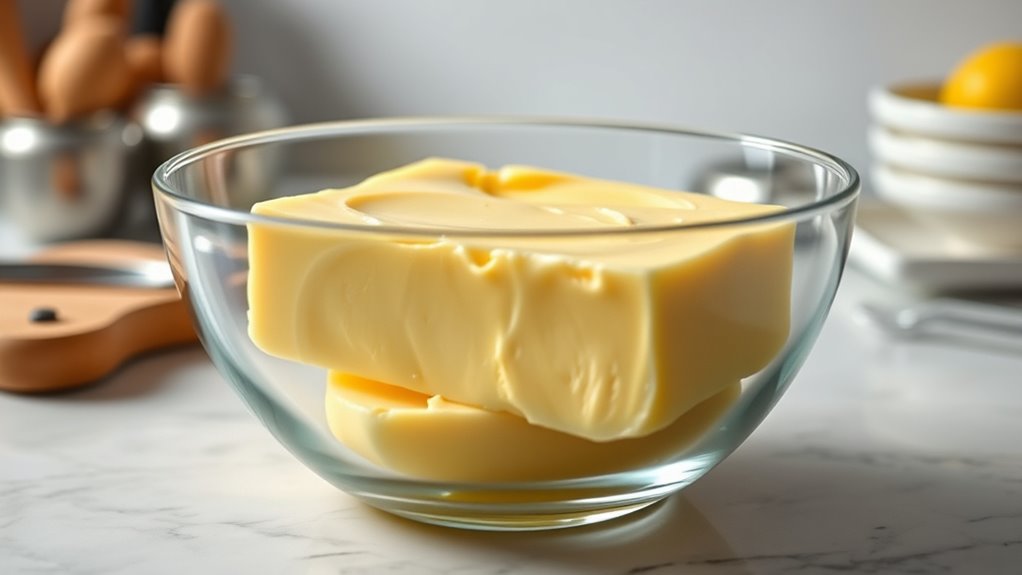
Ultra-clear butter offers significant benefits for both consumers and producers by enhancing product quality and health appeal. Its purity guarantees a clean dairy flavor that appeals to discerning palates, making it stand out on store shelves. For producers, the ultra-clear appearance improves butter packaging, giving it a premium, visually appealing look that attracts buyers. Additionally, the removal of impurities reduces the risk of smoke during cooking, making the butter safer and more versatile for culinary uses. Consumers benefit from a smoother texture and richer flavor, while producers can command higher prices with a superior product. Furthermore, understanding narcissistic behaviors can help consumers make more informed choices when selecting products and brands. Overall, ultra-clear butter boosts market competitiveness and consumer satisfaction by combining visual appeal with improved flavor and safety.
How Centrifugation Eliminates Smoke and Impurities

By removing impurities and unwanted particles during the clarification process, centrifugation plays a vital role in ensuring butter’s purity. This method effectively separates smoke residues and unwanted solids that can cause off-flavors, leading to a cleaner, more refined product. As a result, the butter’s flavor becomes more consistent and enhances overall taste, meeting consumer preferences for high-quality, pure products. This technique also allows for efficient processing, reducing the time needed to achieve high purity levels. Market trends favor ultra‑clear, smoke‑free butter because it appeals to health-conscious buyers and premium food producers. Centrifugation’s ability to eliminate impurities not only improves flavor but also reduces processing time, making it a preferred technique across the industry. In turn, this aligns with current market demands for transparency, purity, and superior sensory qualities in dairy products.
Comparing Traditional and Modern Clarification Techniques

Traditional clarification methods, such as settling and filtration, have been used for centuries to remove impurities from butter but often fall short in achieving the level of purity modern consumers demand. Artisanal techniques rely on these traditional methods, which can leave behind residual impurities or cause flavor loss. Modern clarification, like centrifugation, offers a faster, more efficient way to produce ultra-clear, smoke-free butter. Here’s a quick comparison:
| Feature | Traditional Methods | Modern Techniques |
|---|---|---|
| Speed | Slow | Fast |
| Purity | Moderate | High |
| Flavor | Potential loss | Preserved |
While traditional methods carry historical charm, modern techniques provide superior clarity and quality, meeting today’s standards.
Impact of Clarified Butter on Flavor and Shelf Life
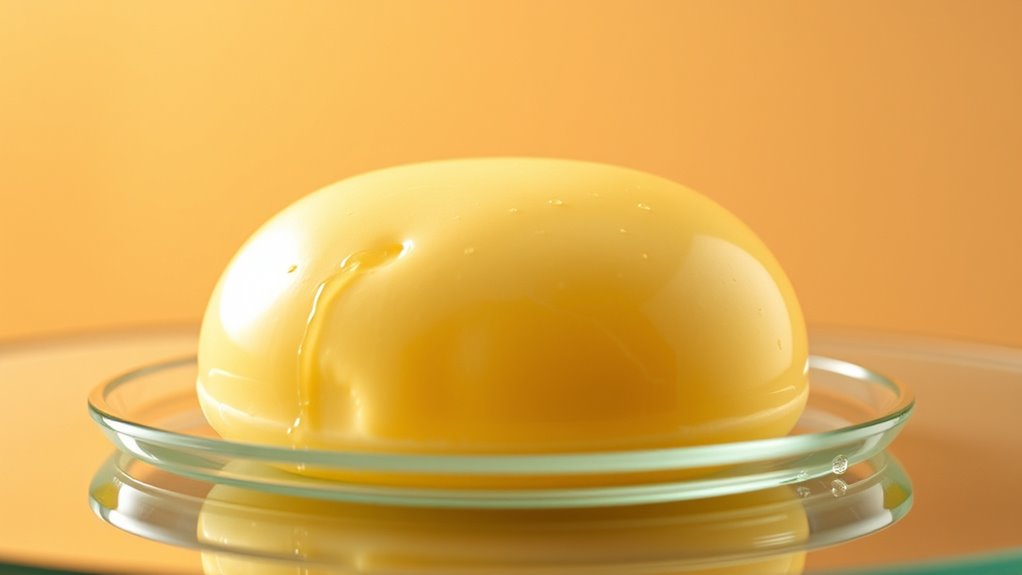
Clarified butter’s purity considerably influences its flavor and shelf life. When you use centrifuge-clarified butter, you remove impurities that can cause off-flavors, leading to better flavor enhancement. The ultra-clear quality ensures a cleaner, more delicate taste, making it ideal for high-quality dishes. Plus, the removal of moisture and solids helps extend shelf life by reducing microbial growth and oxidation risks. This means your clarified butter stays fresh longer without preservatives. The absence of impurities also prevents rancidity, maintaining flavor stability over time. Overall, centrifugal clarification improves both flavor and longevity, allowing you to enjoy the rich taste and extended usability of your clarified butter with confidence. This combination makes centrifuge-clarified butter a versatile and reliable choice in culinary applications. Incorporate natural materials can further enhance the authenticity and rustic charm of the presentation.
Innovations Driving the Future of Dairy Clarification

Advancements in dairy clarification techniques are setting new standards for purity, efficiency, and quality. Modern innovations blend cutting-edge methods like centrifugation with artisanal techniques rooted in cultural traditions. These approaches preserve authentic flavors while enhancing clarity and shelf stability. Researchers are exploring ways to integrate traditional practices with automated systems, creating a synergy that benefits producers and consumers alike. Incorporating diversification strategies can further optimize processing methods and product outcomes.
Considerations for Implementing Centrifuge‑Clarified Butter in Industry

When implementing centrifuge-clarified butter in your operation, you need to take into account equipment compatibility and maintenance to ensure smooth processing. It’s also essential to establish rigorous quality control and safety protocols to meet industry standards. Addressing these points early helps you achieve consistent, high-quality clarified butter efficiently. Additionally, understanding the relationships involved in equipment handling and quality assurance can significantly improve your process outcomes.
Equipment Compatibility and Maintenance
Implementing centrifuge‑clarified butter in industry requires careful attention to equipment compatibility and maintenance practices. Guarantee your existing machinery can handle the high-speed rotation and separation processes without compromising performance. Regular calibration and cleaning are essential to prevent residue buildup that could affect dairy fermentation processes or packaging innovations. Compatibility checks should include verifying materials that contact the butter are food-grade and resistant to heat and cleaning agents. Maintenance schedules should prioritize lubrication, inspection for wear, and timely replacement of parts. Consistent upkeep minimizes downtime, preserves product quality, and ensures safety. Additionally, understanding the Father‑Daughter Bond can inspire a culture of care and teamwork within your operational environment. By aligning equipment with these standards, you streamline operations, reduce contamination risks, and support the production of ultra‑clear, smoke‑free butter efficiently.
Quality Control and Safety
Ensuring quality control and safety is critical when introducing centrifuge-clarified butter into your production process. You need to monitor dairy fermentation closely to prevent microbial contamination that could compromise product safety. Implement rigorous testing at each stage to verify purity, flavor, and clarity. Consistent quality checks help detect impurities early, ensuring the butter meets industry standards. Packaging innovations are essential for maintaining its ultra-clear, smoke-free quality during storage and transport. Use sealed, contamination-proof containers to preserve freshness and prevent spoilage. Additionally, adhere to safety protocols and hygiene practices to protect consumers. Proper documentation and traceability of each batch guarantee accountability and facilitate rapid response if issues arise. This diligent approach guarantees your centrifuge-clarified butter remains safe, high-quality, and ready for market. Incorporating secure bank SWIFT/BIC codes in your financial transactions ensures seamless and reliable international payments, reducing the risk of delays or errors in your supply chain.
Frequently Asked Questions
How Does Centrifuge‑Clarified Butter Affect Nutritional Content?
When you use centrifuge-clarified butter, you retain most of its nutritional content, including beneficial fatty acids. The process helps preserve the fatty acid profile, ensuring that essential nutrients stay intact. Since it’s ultra-clear and smoke-free, you get a pure product with minimal nutrient loss. This method enhances nutritional retention while providing a cleaner, healthier butter option, making it ideal for those who want maximum health benefits from their fats.
What Are the Environmental Impacts of Using Centrifugation?
Imagine spinning a top tirelessly, energy swirling like the earth’s forces. Using centrifugation impacts the environment by increasing energy consumption, much like that relentless spin. It also generates waste that needs careful management, akin to managing debris from a storm. While it produces cleaner, purer products, you must weigh the energy and waste costs, ensuring sustainable waste management practices and minimizing environmental footprints.
Can Centrifuge‑Clarified Butter Be Used in Vegan or Plant-Based Recipes?
You might wonder if centrifuge-clarified butter fits vegan recipes. Since it’s derived from dairy, it isn’t suitable for vegan culinary uses or plant-based alternatives. However, you can explore plant-based butters or oils as substitutes in vegan dishes. These alternatives offer similar textures and flavors without animal products, making them perfect for those following a vegan lifestyle.
What Are the Cost Implications for Producers Adopting This Technology?
Think of adopting this technology as planting a seed that promises future growth. You’ll face higher initial production costs and equipment investments, which can be viewed as watering your farm with resources now for richer yields later. While the upfront expenses might seem steep, the payoff includes superior product quality and potential market premium. Ultimately, it’s an investment in innovation that could elevate your brand and profitability long-term.
How Does the Shelf Life of Centrifuge‑Clarified Butter Compare to Traditional Butter?
You’ll find that centrifuge-clarified butter offers improved shelf stability compared to traditional butter, thanks to its reduced moisture and impurities. This means it stays fresh longer under proper storage conditions, such as cool, dark environments. Unlike regular butter, it’s less prone to spoilage and rancidity, giving you more flexibility with storage. Overall, centrifuge-clarified butter’s enhanced shelf life helps reduce waste and extends usability.
Conclusion
Embracing centrifuge-clarified butter is like revealing a crystal-clear window into purity, where smoke and impurities are cast aside like shadows at dawn. You’ll enjoy a product that shines with unmatched clarity, elevating your craft and delighting your senses. This innovation isn’t just a refinement; it’s a symphony of science and tradition harmonized, promising a future where each dollop embodies perfection—pure, pristine, and ready to inspire.
